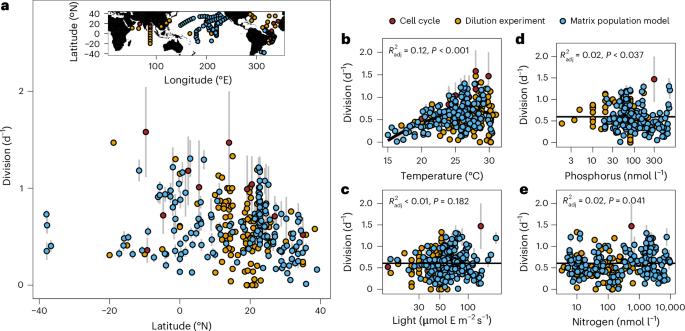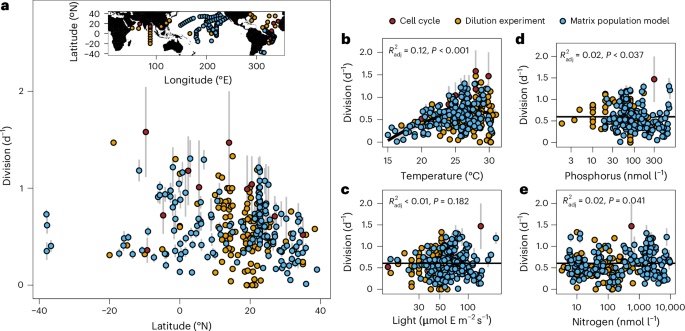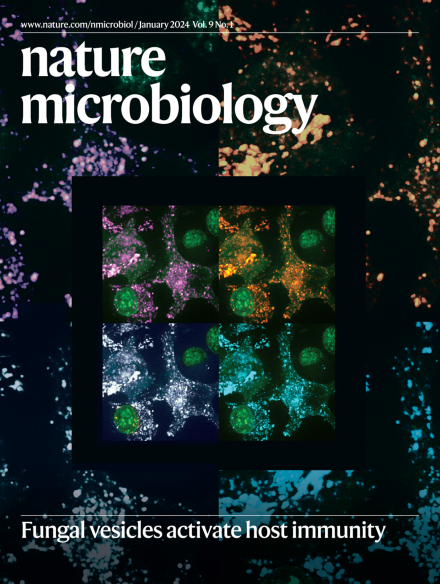未来的海洋变暖可能会导致原绿球藻生物量和生产力的大幅减少
IF 19.4
1区 生物学
Q1 MICROBIOLOGY
引用次数: 0
摘要
蓝藻原绿球藻是地球上最丰富的光合生物,对海洋生态系统至关重要。然而,它对气候变化的敏感性仍不清楚。在这里,我们使用海底仪器的连续流式细胞术分析了长达十年的现场测量结果,收集了热带和亚热带太平洋上约8000亿浮游植物细胞的每细胞叶绿素荧光和大小数据,以量化细胞分裂的温度依赖性。原绿球藻的分裂率主要由温度决定,在28℃时呈指数增长,然后急剧下降。在中度和高度变暖情景下,到本世纪末区域地表水温度都可能超过这一范围。在这些未来条件下,我们的全球海洋生态系统模型显示热带海洋原绿球藻产量可能减少17-51%。即使包括假设的暖适应菌株,模型也显示在最温暖的地区产量显著下降,这表明热适应可能无法防止负面影响。这些结果突出了依赖原绿球藻的海洋生态系统对未来变暖的潜在脆弱性。本文章由计算机程序翻译,如有差异,请以英文原文为准。


Future ocean warming may cause large reductions in Prochlorococcus biomass and productivity
The cyanobacterium Prochlorococcus is Earth’s most abundant photosynthetic organism and crucial to oceanic ecosystems. However, its sensitivity to a changing climate remains unclear. Here we analysed decade-long field measurements using continuous-flow cytometry from our SeaFlow instrument, collecting per-cell chlorophyll fluorescence and size data for ~800 billion phytoplankton cells across the tropical and subtropical Pacific Ocean to quantify the temperature dependence of cell division. Prochlorococcus division rates appear primarily determined by temperature, increasing exponentially to 28 °C, then sharply declining. Regional surface water temperatures may exceed this range by the end of the century under both moderate and high warming scenarios. Under these future conditions, our global ocean ecosystem model suggests a possible 17–51% reduction in Prochlorococcus production in tropical oceans. Even with the inclusion of hypothetical warm-adapted strains, models show significant production declines in the warmest regions, suggesting that thermal adaptation may not prevent negative impacts. These results highlight the potential vulnerability of Prochlorococcus-dependent marine ecosystems to future warming. Decade-long field measurements and modelling show that projected ocean temperatures could restrict cell division rates of an important marine cyanobacterium.
求助全文
通过发布文献求助,成功后即可免费获取论文全文。
去求助
来源期刊

Nature Microbiology
Immunology and Microbiology-Microbiology
CiteScore
44.40
自引率
1.10%
发文量
226
期刊介绍:
Nature Microbiology aims to cover a comprehensive range of topics related to microorganisms. This includes:
Evolution: The journal is interested in exploring the evolutionary aspects of microorganisms. This may include research on their genetic diversity, adaptation, and speciation over time.
Physiology and cell biology: Nature Microbiology seeks to understand the functions and characteristics of microorganisms at the cellular and physiological levels. This may involve studying their metabolism, growth patterns, and cellular processes.
Interactions: The journal focuses on the interactions microorganisms have with each other, as well as their interactions with hosts or the environment. This encompasses investigations into microbial communities, symbiotic relationships, and microbial responses to different environments.
Societal significance: Nature Microbiology recognizes the societal impact of microorganisms and welcomes studies that explore their practical applications. This may include research on microbial diseases, biotechnology, or environmental remediation.
In summary, Nature Microbiology is interested in research related to the evolution, physiology and cell biology of microorganisms, their interactions, and their societal relevance.
 求助内容:
求助内容: 应助结果提醒方式:
应助结果提醒方式:


